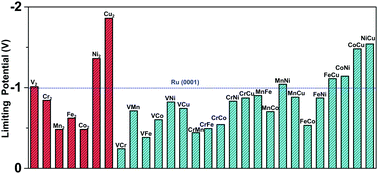Electrocatalytic nitrogen reduction on the transition-metal dimer anchored N-doped graphene: performance prediction and synergetic effect†
Abstract
Double-atom catalysts (DACs) have gained more and more attention to achieve efficient catalysts for the electrocatalytic nitrogen reduction reaction (NRR). It is expected that heteronuclear members could play an important role in the development of DACs, due to which the vast possible combinations of two different transition metal (TM) elements provide a large chemical composition space for the DAC design. Herein, to screen for efficient NRR DACs and, in particular, to further explore the synergetic effect as well as the TM combination pattern conductive to the NRR in the heteronuclear DACs, we have theoretically studied the NRR on TM dimer embedded N-doped porous graphene (TM = V, Cr, Mn, Fe, Co, Ni, and Cu), denoted as M1M2@NG, and both homonuclear and heteronuclear DACs have been considered. Our results indicate that most of the M1M2@NG systems exhibit comparable or better intrinsic NRR activity than the stepped Ru(0001) surface in terms of the calculated limiting potential. In particular, the heteronuclear DAC VCr@NG exhibiting metallic conductivity and high stability has an ultralow limiting potential of −0.24 V for the NRR and a strong capability of suppressing the competing hydrogen evolution reaction. Moreover, the synergetic effect for the heteronuclear DACs compared with the homonuclear counterparts has been studied in terms of energy and electronic structures. Based on this, we propose that combining a highly chemically active TM element (often the early TM) with another TM to form heteronuclear TM dimers on an appropriate substrate can help achieve efficient heteronuclear DACs for the NRR. Our studies not only highlight the important role of heteronuclear members in the application of DACs, but further provide a promising strategy to design efficient heteronuclear DACs for the NRR from the large chemical composition space.

- This article is part of the themed collection: Energy Frontiers: Electrochemistry and Electrochemical Engineering


 Please wait while we load your content...
Please wait while we load your content...